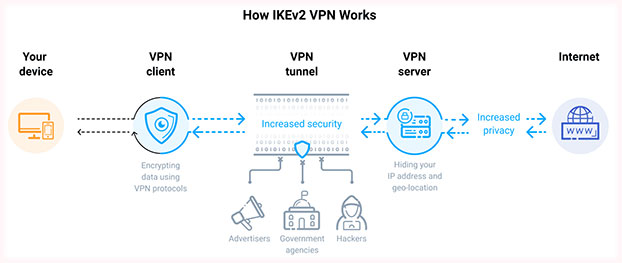What are IKE and IKEv2 VPN protocols?
The first version of the protocol (IKEv1) was introduced in 1998 and the second version (IKEv2) was released seven years later. There are several differences between IKEv1 and IKEv2, of which IKEv2 reduces bandwidth requirements.
A detailed introduction to IKEv2
Why use IKEv2?
- 256-bit data encryption
- Implement IPSec for security
- The connection is stable and consistent
- MOBIKE support ensures better speeds

Security
IKEv2 uses server certificate authentication, which means it will not take any action until the identity of the requester is determined. This fails in most man-in-the-middle and DoS attack attempts.
Reliability
In the first version of the protocol, if you try to switch to a different Internet connection, for example from WiFi to mobile Internet, when the VPN is turned on, it will interrupt the VPN connection and will request to reconnect.
This has certain undesirable consequences like performance degradation and altered previous IP addresses. Thanks to the reliability related measures adopted in IKEv2, this problem has been overcome.
In addition, IKEv2 implements MOBIKE technology, allowing it to be used by mobile users and many others. IKEv2 is also one of the few protocols that support Blackberry devices.
Speed
IKEv2's good architecture and efficient communication system deliver better performance. Also, its connection speed is significantly higher, especially due to the built-in NAT transport feature which makes it much faster to bypass the firewall and establish a connection.
Features and technical details
IKE's goal is to create the same symmetric key for all parties to communicate independently. This key is used to encrypt and decrypt common IP packets, used to transfer data between VPN peers.
IKE builds a VPN tunnel by authenticating both parties and reaching agreement on encryption methodology and integrity.
IKE relies on basic security protocols, such as the Internet Security Association and Key Management Protocol (ISAKMP), A Versatile Secure Key Exchange Mechanism for internet (SKEME), and the Oakley Key Determination Protocol.

ISAKMP specifies a framework for authentication and key exchange, but does not define them. SKEME describes a flexible key exchange technique that provides fast key refresh.
Oakley allows authenticated parties to exchange key documents over an insecure connection, using the Diffie – Hellman key exchange algorithm. This method provides a perfect secret forward method for keys, identity protection, and authentication.
The IKE protocol uses the UDP 500 port perfect for network applications where perceived latency is critical, such as games, voice and video communications. Furthermore, the protocol is linked with Point-to-Point (PPP) protocols.
This makes IKE faster than PPTP and L2TP. With the support of AES and Camellia ciphers with a key length of 256 bits, IKE is considered a very secure protocol.
Advantages and disadvantages of the IKEv2 protocol
- Faster than PPTP and L2TP
- Supports advanced encryption methods
- Stable when changing the network and re-establishing the VPN connection, when the connection is temporarily lost
- Provides enhanced mobile support
- Easy to set up
- Using a UDP port 500 may be blocked by some firewalls
- Not easy to apply on the server side
You should read it
- How to choose the best connection protocol for IoT devices
- Knowledge of TCP / IP network protocols
- Wireless Application Protocol (WAP) price, marketcap, chart, and fundamentals info
- Learn about DNSCrypt protocol
- Learn about the IMAP protocol
- Learn about Telnet protocol
- Download Broke Protocol, the 'weird' game between GTA and Minecraft is free on Steam
- What is Post Office Protocol (POP)?
May be interested
- Knowledge of TCP / IP network protocols
 tcp / ip or transmission control protocol / internet protocol is a set of communication protocols used to connect network devices on the internet.
tcp / ip or transmission control protocol / internet protocol is a set of communication protocols used to connect network devices on the internet. - Using POP3 and IMAP4 to access Exchange 2007 (Part 1)
 pop3 (post office protocol 3) and imap4 (internet message access protocol 4) are protocols that allow mail access from a remote control server. both of these protocols are also widely used outside the business to serve access and mail.
pop3 (post office protocol 3) and imap4 (internet message access protocol 4) are protocols that allow mail access from a remote control server. both of these protocols are also widely used outside the business to serve access and mail. - Use Terminal on Mac as FTP or SFTP Client
 file transfer protocol (ftp) and secure file transfer protocol (sftp) are two commonly used protocols for moving files and data between local devices and remote servers. these protocols are frequently used by web developers to change their servers, and there are many ftp clients available.
file transfer protocol (ftp) and secure file transfer protocol (sftp) are two commonly used protocols for moving files and data between local devices and remote servers. these protocols are frequently used by web developers to change their servers, and there are many ftp clients available. - Instructions for downloading files on Motrix - Supports downloading files on many protocols
 motrix is a file download tool that supports many protocols and downloads torrent files quickly.
motrix is a file download tool that supports many protocols and downloads torrent files quickly. - Google uses HTTPS protocol for Gmail
 google announced on march 21 that gmail has now adopted the https security protocol when users send or receive email, regardless of which connection network it uses.
google announced on march 21 that gmail has now adopted the https security protocol when users send or receive email, regardless of which connection network it uses. - This is how hackers attack your Bitcoin wallet online
 for years, researchers have been warning about serious problems with signaling system 7 (ss7) - a set of phone protocols, but nothing has improved. see how hackers attack bitcoin wallet through ss7 vulnerability!
for years, researchers have been warning about serious problems with signaling system 7 (ss7) - a set of phone protocols, but nothing has improved. see how hackers attack bitcoin wallet through ss7 vulnerability! - Discover 2 new vulnerabilities on 2 popular email protocols
 this vulnerability affects two of the very popular email protocols, pgp and s / mime, although the degree of impact depends on the use of the client software's protocol. quite a lot of email client software is affected, including apple mail, mail application on ios and thunderbird.
this vulnerability affects two of the very popular email protocols, pgp and s / mime, although the degree of impact depends on the use of the client software's protocol. quite a lot of email client software is affected, including apple mail, mail application on ios and thunderbird. - How to set up VPN on a Mac
 setting up a vpn on a mac is really easy. macos has built-in support and some vpn services provide their own software. you can also install third-party tools to use different protocols.
setting up a vpn on a mac is really easy. macos has built-in support and some vpn services provide their own software. you can also install third-party tools to use different protocols. - 4 ways to bypass blocked Torrent connection
 the torrent protocol is one of the most powerful p2p protocols available. but for many reasons not everyone recognizes the convenience of sharing this file.
the torrent protocol is one of the most powerful p2p protocols available. but for many reasons not everyone recognizes the convenience of sharing this file. - TCP and IP options
 going back to the basics is always a good idea. one of the most basic parts of computer communication knowledge is four basic protocols: ip, tcp, udp and icmp.
going back to the basics is always a good idea. one of the most basic parts of computer communication knowledge is four basic protocols: ip, tcp, udp and icmp.










 How to verify Google Authenticator on Windows PC
How to verify Google Authenticator on Windows PC What is Website Traffic Fingerprinting? Is it dangerous?
What is Website Traffic Fingerprinting? Is it dangerous? Reviews on Opera VPN: Simple, fast and free
Reviews on Opera VPN: Simple, fast and free How to turn off firewall on Windows 7,8,10
How to turn off firewall on Windows 7,8,10 What is SSTP (Secure Socket Tunneling Protocol)?
What is SSTP (Secure Socket Tunneling Protocol)? Fix the error that cannot delete the VPN connection
Fix the error that cannot delete the VPN connection